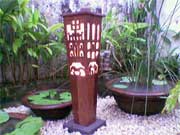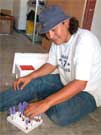This is the old Ternyata site, maintained for archival purposes. You can see the new site at http://www.ternyata.org
By Elizabeth Pisani
758 words
8 December 1995
Asia Times
(c) 1995 Chamber World Network International Ltd
Old-timers at Japanese electronics giant Sony may have a sense of deja vu in Vietnam. Two decades after the company left the country it is back in exactly the same factory.
"When we came back, this place was like a museum," said Sony Vietnam's general director Masaaki Terada.
Now sleek machines stamp out circuit boards and rows of uniformed workers piece together high-tech components to make televisions, hi-fis and video players.
While many foreign investors in Vietnam tear their hair out, Sony has struck a formula that seems to be serving it well. It started small, stays flexible and is selling local. The initial investment was just US$2 million, and Sony's joint venture partner, Vietronics, a company owned by the Ministry of Industry, was able to put up 30 percent of that in cash.
In most joint ventures, the Vietnamese partner contributes land and buildings. Regularly overvalued, these turn in to millstones around the companies' necks preventing them from expanding to new premises. Sony, however, leases its current site from its partner, allowing Vietronics to recoup its cash contribution in just two years. Such deals, vital to Sony's success, are a thing of the past.
"The government doesn't approve such tricks any more," said one business analyst. "They want big investment and they want it for nothing."
The company, which has been operating for a year and was profitable almost from the outset, estimates it will turn over US$50 million in 1995. It operates at full capacity, producing 10,000 color televisions, 10,000 audio units and 5,000 video cassette recorders a month. Ironically, Sony's biggest competitor in the Vietnamese market is Sony itself. Shops on street corners throughout the country are these days piled high with smuggled merchandise and Sony estimates that for every four units of local production it sells in the Vietnamese market, another six units are sold by smugglers.
"There is a very deep-seated prejudice against anything Made in Vietnam in this market, and the smugglers can offer imported goods," Terada said.
This leaves Sony in the uncomfortable position of letting the smugglers set the price, matching street corner sales as closely as possible.
"Sometimes it means we sell at cost," Terada said. "But on some models, the smugglers charge a huge premium so we actually make more money by matching their price than we otherwise would."
The Hanoi government is a little ambiguous about production for the local market. It dreams that companies like Sony will start exporting around the region from their Vietnamese factories. Despite much fanfare in the local press about a shipment of cassette recorders to Singapore two years ahead of schedule, Terada said there was still a long way to go before that dream came true.
The shipment, a mere 3,000 units, was a once-off order of a model too antiquated to produce at the companies higher-tech factories in Malaysia.
In general, producing for export remains unprofitable in Vietnam, principally because there is no components industry there. "Even the plastic for the TV cases is imported. We could source it here, maybe, but we would end up with TVs that look like buckets," Terada said.
Generally, when a company like Sony moves in to a market, suppliers of components swarm in, like bees to a honey pot.
"I get maybe 100 calls a month from companies around the region wanting to set up right next to us. I tell them they can't get the material," the Japanese manager said.
For now, Sony only buys packaging materials and manuals locally, and the Vietnamese tax structure makes simple things more expensive than imports.
On the plus side of the balance sheet is labor productivity. In front of each worker on the factory floor is a myriad of different-colored components and a labyrinthine map of their layout. "Here each worker can cope with up to 25 different components. In Indonesia, one person puts in three parts, in China, only one," Terada said.
Although the company pays its workers well, around US$130 a month, or over four times the minimum wage, it still considers that money well spent. The headache comes with infrastructure.
Power cuts, congested ports and difficulties getting the product to market all eat into productivity so that overall output per worker is about half the level of Malaysia.
Copyright 1995 Asia Times.
(c) 1995 Chamber World Network International Ltd.
|




